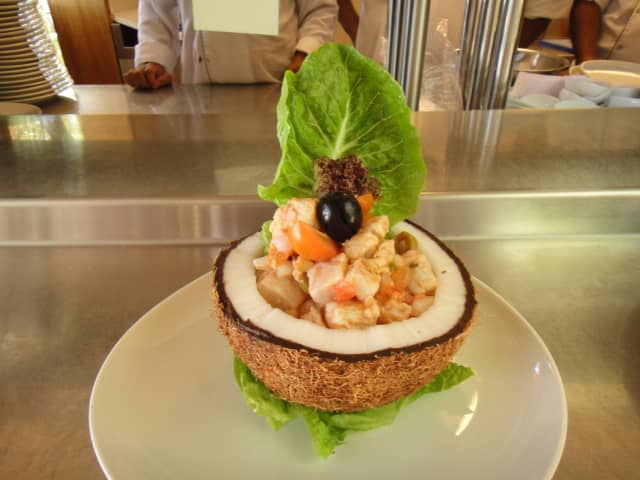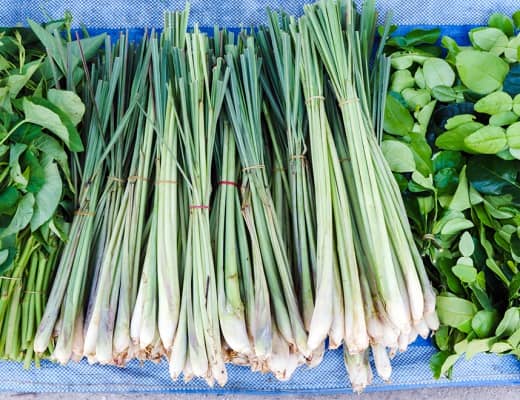Maldivian cuisine, also known as Dhivehi cuisine, is a fascinating blend of flavours influenced by the country’s island geography, rich history, and its neighbours like Sri Lanka and India.
Get ready to tantalise your taste buds with fresh seafood, fragrant curries, and unique local ingredients like coconut and chilies.
In this blog post, we’ll embark on a delicious journey through the Maldives, uncovering 5 key ingredients in Maldivian cuisine and offering a glimpse into the deep-rooted food culture of this island paradise.
So, buckle up (or loosen your belt?) as we dive into the delightful world of Maldivian gastronomy!
Tuna – a staple in Maldivian cuisine
Tuna reigns supreme in Maldivian cuisine. From breakfast favourites like Mas Huni (shredded smoked tuna with coconut and onions) to hearty curries (Mas Riha) and light broths (Garudhiya), tuna features prominently throughout the day.
This versatile fish is a staple, enjoyed fresh, dried, or even ground into a flavourful paste known as Rihaakuru. This concentrated tuna essence adds depth and complexity to countless dishes.
Whether you savour it grilled and flaky, cured for a salty bite, or experience its unique umami richness in Rihaakuru, tuna is guaranteed to delight your palate throughout your Maldivian culinary adventure.
Maldives tuna curry recipe
Dive deeper into the vibrant flavours of the Maldives with this recipe of the famous Maldives tuna curry. A fragrant dish showcasing the island nation’s love for fresh seafood and aromatic spices you could try at home.
The Maldives version of curry powder
With its Asian influence, curry reigns supreme as one of the most comforting and common dishes in the Maldives.
As mentioned earlier, Mas Riha are curries that propose a vibrant tapestry of flavours. Diced tuna takes centre stage, simmered in a fragrant coconut milk broth infused with a blend of warming spices like turmeric, curry powder, and chilies.
The result is a rich and flavourful curry, often served with fluffy roti or steamed rice – a perfect example of how Maldivian cuisine uses fresh, local ingredients to create an explosion of taste.
Recipe with Maldivian curry powder
Embark on a journey to neighbouring Southeast Asia with Halaveli’s shrimp Laksa. It’s a comforting noodle soup bursting with the warmth of curry powder and the unique creaminess of coconut milk. Your guests or family will love it!
Chilli – to spice up Maldivian dishes
Chillies find their way into everything from the national dish, Garudhiya (fish broth), to the local grilled fish staple. Some Maldivians even enjoy a plate of raw chilies alongside their meals for an extra burst of spice!
One particularly popular variety is the “githeyo mirus,” also known as the Scotch Bonnet chili, considered one of the top five hottest peppers globally. However, fear not, spice levels can be adjusted, and milder dishes are readily available throughout the Maldives.
Maldivian recipe with chilli
Light up your taste buds with grilled squid and Moofushi chilli tomato preserve. This succulent dish showcases the Maldives’ love for fresh seafood and a touch of heat.
Coconut – a premium in Maldivian cuisine
The humble coconut is premium in Maldivian cuisine, offering a versatility that stretches from savoury to sweet. This island staple is used in a multitude of forms, each adding a distinct touch to the dish.
Grated coconut, often prepared using the traditional ‘hunigondi‘ grater, finds its way into breakfast favourites and adds textural contrast to curries.
For a richer and creamier element, the grated coconut is squeezed to extract its precious coconut milk, the base for countless curries, soups, and even beverages.
Finally, the remaining flesh can be pressed to extract coconut oil, a popular choice for stir-frying and deep-frying due to its high smoke point.
This resourceful use of the coconut exemplifies Maldivian cuisine’s ability to create delicious dishes from nature’s bounty.
Recipe with coconut
End your culinary journey on a sweet note with a slice of homemade coconut cake. This delightful dessert captures the essence of this island nation’s love for sweet delicacies.
Avocado – locally grown and delicious
While the Maldives’ sandy soil and limited freshwater might suggest otherwise, a surprising number of exotic fruits and vegetables thrive in this island nation. Thanks to clever techniques like raised garden beds and irrigation systems using rainwater, Maldivians cultivate a wider range of produce than you might expect.
Key ingredients like chilies, essential for their fiery kick, and curry leaves, adding a unique aromatic depth, are grown locally. Even some tropical fruits like pineapples and mangoes find their place in Maldivian cuisine, offering a refreshing counterpoint to the savoury dishes. However, it’s important to note that due to the island’s small landmass and reliance on imports, some more exotic options like avocados may be less readily available or more expensive.
The focus remains on using fresh, locally-sourced ingredients whenever possible, showcasing the resourcefulness and adaptability that defines Maldivian cuisine.
Maldivian recipe with avocado
For a light dish option, try Constance Fish Ceviche Acapulco style featuring fresh, local seafood cured in citrus juices and balanced with the creamy richness of avocado.

Fish ceviche acapulco style
Maldivian flavours at Constance
This blend of European and Maldivian cuisine is at the heart of the menus at Constance Moofushi‘s Manta and Alizée restaurants while a rich fusion of flavours is served up against the stunning backdrop of the Indian Ocean at Constance Halaveli‘s romantic Jing restaurant. And if it’s a barefoot vibe you’re after, the fresh seafood cooked on the beach is the theme at Meeru’s beach grill.
So, come hungry and prepare to take part into a delightful culinary journey through the Maldives. You could treat yourself with the most sophisticated food with only five local ingredients.







No Comments